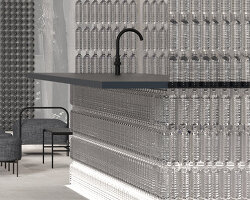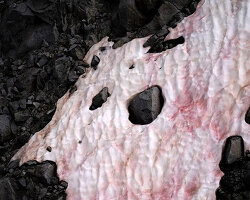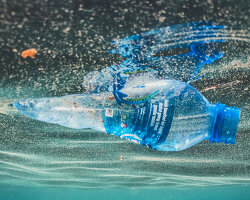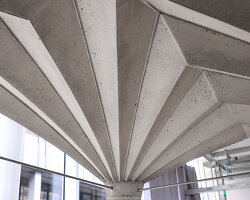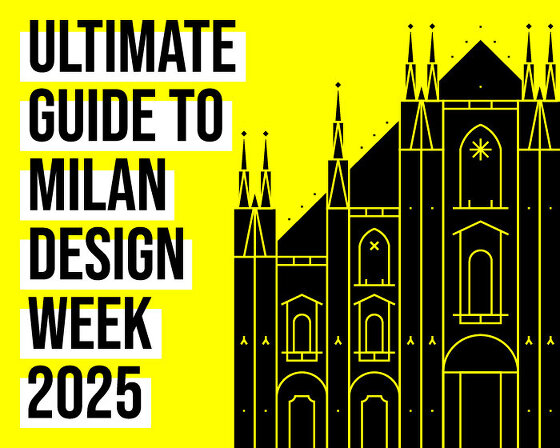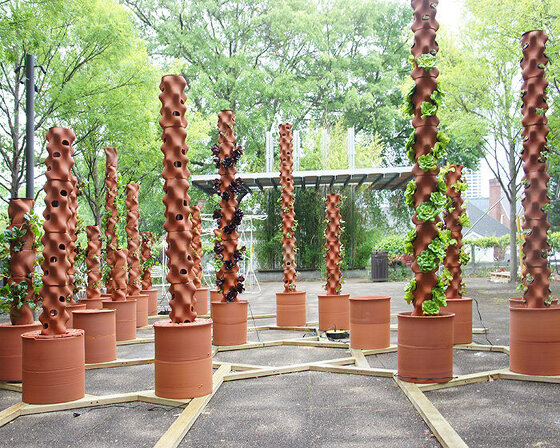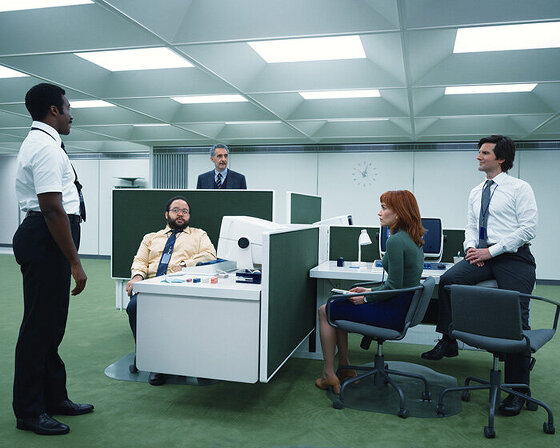climate chronicles: bioprinting with yeast and uv light
A group of graphic design students from Auburn University has spent four months growing posters in a darkroom to raise awareness about climate pollution. Their series Climate Chronicles: Images of Yesterday, Today, and Tomorrow sheds light on how humanity has impacted our environment over the last 200 years, while inspiring greater action to reach net zero emissions by 2050.
To look at the past, present, and future, the students utilized a bioprinting process known as mycography which involves growing living organisms in a darkroom, using baker’s yeast and UV light to develop images on agar plates, somewhat replicating the essence of analog photography.

mycograph representing our present landscapes in the Anthropocene | all images courtesy of the author
mycography replicates the essence of analog photography
Students Erika Donley, Alyssa Jackson, Grace Lovell, and Zach Smith created Climate Chronicles during their spring semester as they learnt about the experimental mycography printmaking technique alongside Assistant Professor Devon Ward. This method, adapted from Johanna Rotko’s method for creating smaller yeast prints, shares similarities with analog photography techniques, with a few modifications. First, photo paper is replaced with baker’s yeast that is grown on 30 cm x 40 cm agar plates, while the small 35mm negative of traditional photography is replaced with a large transparency sheet, upon which students printed the negative of their designs. UV light also replaces traditional bulbs found in darkroom photo projectors, acting as a growth inhibitor for baker’s yeast. After 48-72 hours, a living image is formed and once the UV exposure is finished, the yeast continues to grow — expresses its agency — and eventually, the image disappears.
With mycography, there is no standardization, no perfect high-fidelity image, introducing an element of chance into the design process that ensures each print is unique as the baker’s yeast reacts differently to each exposure. This idea — that the image produced is not fully within one’s control — became the metaphor for Climate Chronicles, and the aleatoric interaction between baker’s yeast and designer represents our relationship with the natural world. This limited control and inherent variability serves as a reminder of the need for adaptability and flexibility in our approach to environmental issues.

the mycograph’s image depicting a speculative future was created with Midjourney
questioning the past, present & future of our environment
The final mycographs of Climate Chronicles represent the three landscapes of the past, the present, and the future. Interested in self-expression and reflection, the students sought to re-present history back to the viewer to create a moment to contemplate how our relationship with the environment has changed over time. The first image focussing on the past showcases a mycograph of the 1810 painting ‘Monk by the Sea’ by David Caspar Friedrich, created at the time where environmental effects of the Industrial Revolution had yet to be fully felt and depicting the sublime. The second mycograph focuses on the present, depicting a photo taken by Konstantinos Tsakalidis during the 2021 wildfires in Greece, representing the tragedy of the Anthropocene.
The final image focuses on the future as a warning sign. It features a mycograph of a speculative landscape with crumbling skyscrapers, run-down infrastructure, and rubble lining the city streets. The students created it with Midjourney, an AI image-generation software, using a simple prompt: ‘Climate change. Collapsed society.’ This mycograph reflects a fear that civilization will not meet its goal of limiting global temperature rise to only 1.5°C (2.7°F) above pre-industrial temperatures.

depicting past landscapes prior to climate pollution, featuring a reprint of Caspar David Friedrich’s 1810 painting
Ultimately, Climate Chronicles is a triptych that reveals how humans have impacted our environment over the past 200 years. It features landscapes throughout time: a painting from the past, a photograph from our present, and an AI-generated image of a speculative future. Together, these three images tell a story of human hubris over the past two hundred years: From the steam engine to the automobile and the voracious consumption of coal and oil to industrial farming and polluted rivers to fast fashion and planned obsolescence to hardware and software that generates e-waste to mindless scrolling that leads to inaction, nihilism, loneliness, and anxiety. ‘Climate Chronicles offers a sobering look at unbridled growth and the concept of ‘progress for the sake of progress.’ It also offers three distinct examples of how our relationship to the environment has changed: from the fear and awe of the natural sublime in the 19th Century to the horror of the Anthropocene in the 20th Century, and to the eco-anxiety about our unknown future in the 21st Century. But the future is not set in stone and the final image does not have to be our fate,’ notes Devon Ward.

Climate Chronicles’ three images depicts past, present, and future landscapes, telling a 200-year story

Zach Smith with final mycograph after 48 hours (12 in x 16 in; 30 cm x 40 cm)

observing the mycograph every 12 hours in the darkroom

three exposure units in the dark room at the School of Industrial and Graphic Design at Auburn University

mixing ingredients to create an agar mold

pouring agar molds to test small-scale mycographs

first test prints using 7.6 cm Petri dish

initial test prints of William Morris patterns, showcasing a duotone image

diagram by Erika Donley, depicting the exposure unit used to create mycographs with baker’s yeast
project info:
name: Climate Chronicles: Images of Yesterday, Today and Tomorrow
designer: Erika Donley, Alyssa Jackson, Grace Lovell, and Zach Smith
instructor: Devon Ward
institution: School of Industrial and Graphic Design College of Architecture, Design and Construction Auburn University
designboom has received this project from our DIY submissions feature, where we welcome our readers to submit their own work for publication. see more project submissions from our readers here.
edited by: ravail khan | designboom

